Abstract
Free lipid A of Helicobacter pylori was characterized with regard to chemical composition, reactivity with anti-lipid A antibodies, and activity in a Limulus lysate assay. The predominant fatty acids of H. pylori lipid A were 3-OH-18:0, 18:0, 3-OH-16:0, 16:0, and 14:0. Hexosamine was present in amounts similar to those in Campylobacter jejuni or Salmonella typhimurium lipid A. The lipopolysaccharide of H. pylori contained 2-keto-3-deoxyoctonic acid, a common constituent of enterobacterial and C. jejuni lipopolysaccharides. In the enzyme-linked immunosorbent assay, the doses of lipid A required to inhibit anti-lipid A by 50% (EI50 values) by absorption of the immune (rabbit) serum were 7.9, 1.2, and 1.4 micrograms of O-deacylated lipid A's from H. pylori, C. jejuni, and S. typhimurium per ml, respectively. The lower reactivity of H. pylori lipid A compared with those of the other two lipid A preparations (as shown by the higher EI50 value) was underscored by the use of a murine monoclonal anti-lipid A antibody in the inhibition assay. An EI50 value was not obtained at the concentrations tested for H. pylori lipid A; the corresponding figures for C. jejuni and S. typhimurium lipid A's were 13 and 14 micrograms/ml, respectively. No inhibition was obtained with H. pylori lipopolysaccharide, which showed a low-molecular-weight profile on sodium dodecyl sulfate-polyacrylamide gel electrophoresis. The activity of H. pylori lipid A in the Limulus assay was approximately 71 and 650 times lower than those of C. jejuni and S. typhimurium lipid A's, respectively. These findings suggest that lipid A is an integral part of the outer cell wall of H. pylori. The lower reactivity of H. pylori lipid A with anti-lipid A antibodies and in the Limulus assay compared with that of C. jejuni or S. typhimurium lipid A may be explained by a different composition of the fatty acids, especially the 3-hydroxy fatty acids, and a possible deviating phosphorylation pattern.
Full text
PDF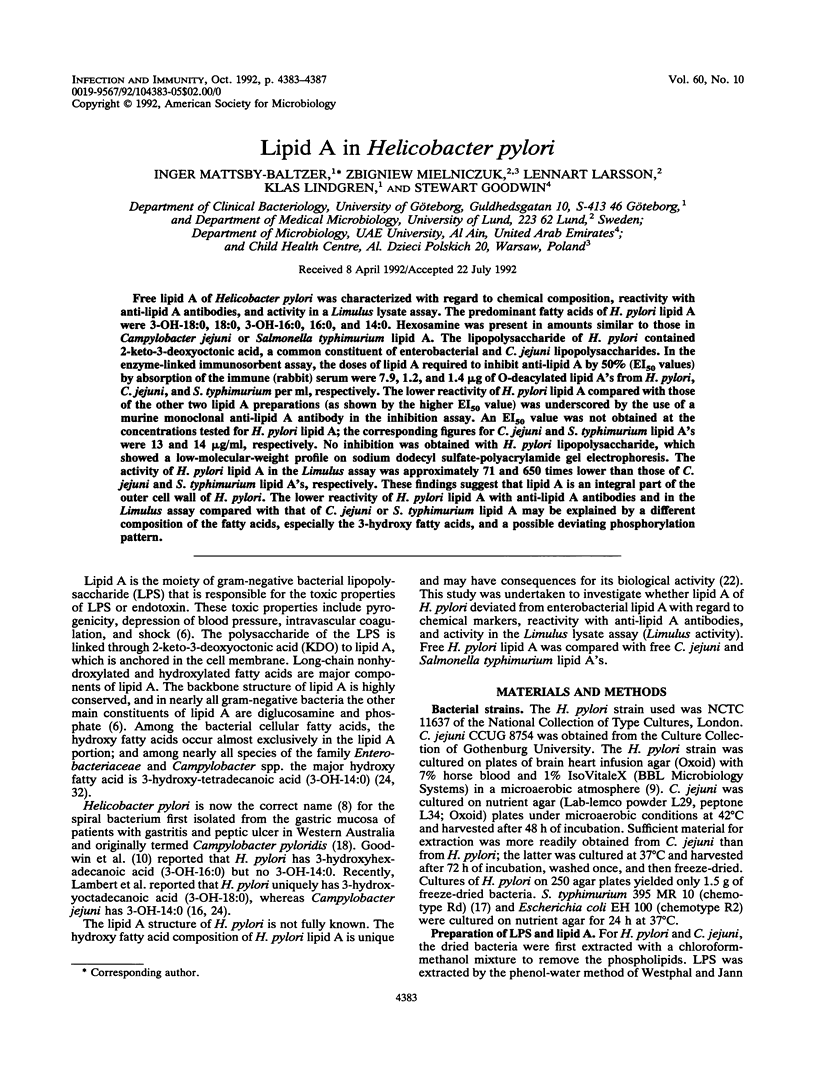
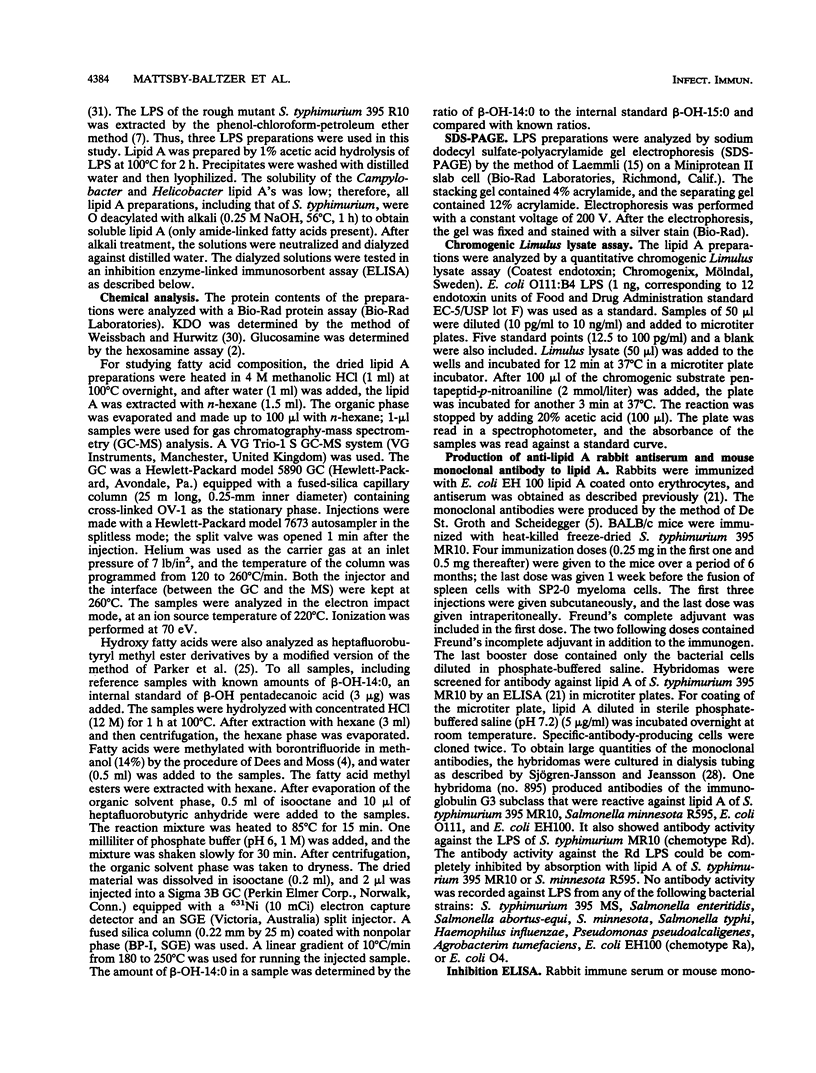
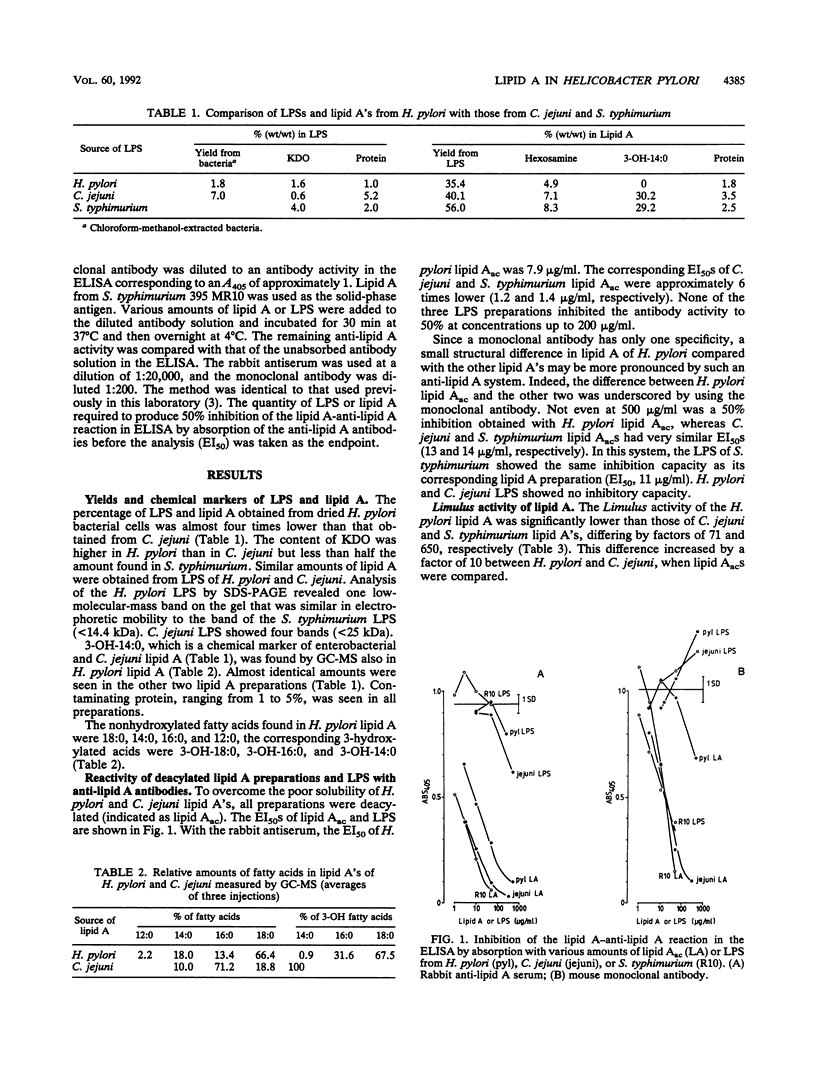
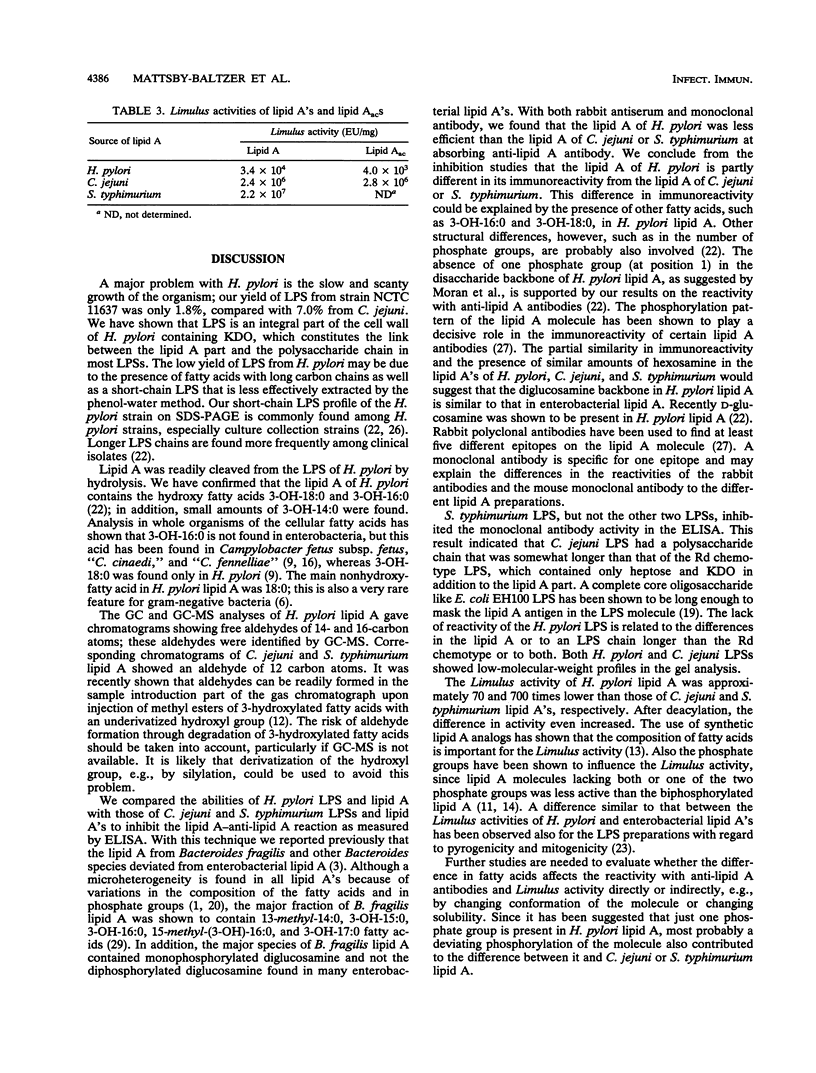
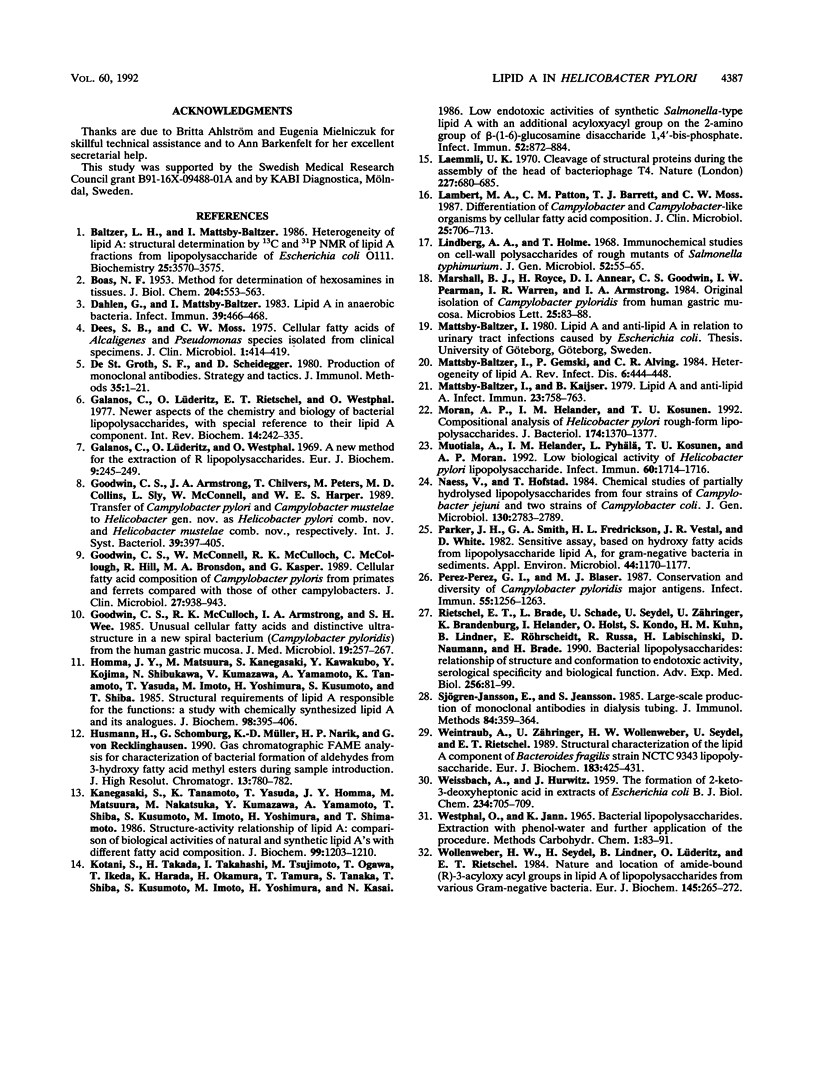
Selected References
These references are in PubMed. This may not be the complete list of references from this article.
- BOAS N. F. Method for the determination of hexosamines in tissues. J Biol Chem. 1953 Oct;204(2):553–563. [PubMed] [Google Scholar]
- Baltzer L. H., Mattsby-Baltzer I. Heterogeneity of lipid A: structural determination by 13C and 31P NMR of lipid A fractions from lipopolysaccharide of Escherichia coli 0111. Biochemistry. 1986 Jun 17;25(12):3570–3575. doi: 10.1021/bi00360a015. [DOI] [PubMed] [Google Scholar]
- Dahlén G., Mattsby-Baltzer I. Lipid A in anaerobic bacteria. Infect Immun. 1983 Jan;39(1):466–468. doi: 10.1128/iai.39.1.466-468.1983. [DOI] [PMC free article] [PubMed] [Google Scholar]
- Dees S. B., Moss C. W. Cellular fatty acids of Alcaligenes and Pseudomonas species isolated from clinical specimens. J Clin Microbiol. 1975 May;1(5):414–419. doi: 10.1128/jcm.1.5.414-419.1975. [DOI] [PMC free article] [PubMed] [Google Scholar]
- Galanos C., Lüderitz O., Westphal O. A new method for the extraction of R lipopolysaccharides. Eur J Biochem. 1969 Jun;9(2):245–249. doi: 10.1111/j.1432-1033.1969.tb00601.x. [DOI] [PubMed] [Google Scholar]
- Goodwin C. S., McConnell W., McCulloch R. K., McCullough C., Hill R., Bronsdon M. A., Kasper G. Cellular fatty acid composition of Campylobacter pylori from primates and ferrets compared with those of other campylobacters. J Clin Microbiol. 1989 May;27(5):938–943. doi: 10.1128/jcm.27.5.938-943.1989. [DOI] [PMC free article] [PubMed] [Google Scholar]
- Goodwin C. S., McCulloch R. K., Armstrong J. A., Wee S. H. Unusual cellular fatty acids and distinctive ultrastructure in a new spiral bacterium (Campylobacter pyloridis) from the human gastric mucosa. J Med Microbiol. 1985 Apr;19(2):257–267. doi: 10.1099/00222615-19-2-257. [DOI] [PubMed] [Google Scholar]
- Homma J. Y., Matsuura M., Kanegasaki S., Kawakubo Y., Kojima Y., Shibukawa N., Kumazawa Y., Yamamoto A., Tanamoto K., Yasuda T. Structural requirements of lipid A responsible for the functions: a study with chemically synthesized lipid A and its analogues. J Biochem. 1985 Aug;98(2):395–406. doi: 10.1093/oxfordjournals.jbchem.a135294. [DOI] [PubMed] [Google Scholar]
- Kanegasaki S., Tanamoto K., Yasuda T., Homma J. Y., Matsuura M., Nakatsuka M., Kumazawa Y., Yamamoto A., Shiba T., Kusumoto S. Structure-activity relationship of lipid A: comparison of biological activities of natural and synthetic lipid A's with different fatty acid compositions. J Biochem. 1986 Apr;99(4):1203–1210. doi: 10.1093/oxfordjournals.jbchem.a135583. [DOI] [PubMed] [Google Scholar]
- Kotani S., Takada H., Takahashi I., Tsujimoto M., Ogawa T., Ikeda T., Harada K., Okamura H., Tamura T., Tanaka S. Low endotoxic activities of synthetic Salmonella-type lipid A with an additional acyloxyacyl group on the 2-amino group of beta (1-6) glucosamine disaccharide 1,4'-bisphosphate. Infect Immun. 1986 Jun;52(3):872–884. doi: 10.1128/iai.52.3.872-884.1986. [DOI] [PMC free article] [PubMed] [Google Scholar]
- Laemmli U. K. Cleavage of structural proteins during the assembly of the head of bacteriophage T4. Nature. 1970 Aug 15;227(5259):680–685. doi: 10.1038/227680a0. [DOI] [PubMed] [Google Scholar]
- Lambert M. A., Patton C. M., Barrett T. J., Moss C. W. Differentiation of Campylobacter and Campylobacter-like organisms by cellular fatty acid composition. J Clin Microbiol. 1987 Apr;25(4):706–713. doi: 10.1128/jcm.25.4.706-713.1987. [DOI] [PMC free article] [PubMed] [Google Scholar]
- Mattsby-Baltzer I., Gemski P., Alving C. R. Heterogeneity of lipid A. Rev Infect Dis. 1984 Jul-Aug;6(4):444–448. doi: 10.1093/clinids/6.4.444. [DOI] [PubMed] [Google Scholar]
- Mattsby-Baltzer I., Kaijser B. Lipid A and anti-lipid A. Infect Immun. 1979 Mar;23(3):758–763. doi: 10.1128/iai.23.3.758-763.1979. [DOI] [PMC free article] [PubMed] [Google Scholar]
- Moran A. P., Helander I. M., Kosunen T. U. Compositional analysis of Helicobacter pylori rough-form lipopolysaccharides. J Bacteriol. 1992 Feb;174(4):1370–1377. doi: 10.1128/jb.174.4.1370-1377.1992. [DOI] [PMC free article] [PubMed] [Google Scholar]
- Muotiala A., Helander I. M., Pyhälä L., Kosunen T. U., Moran A. P. Low biological activity of Helicobacter pylori lipopolysaccharide. Infect Immun. 1992 Apr;60(4):1714–1716. doi: 10.1128/iai.60.4.1714-1716.1992. [DOI] [PMC free article] [PubMed] [Google Scholar]
- Naess V., Hofstad T. Chemical studies of partially hydrolysed lipopolysaccharides from four strains of Campylobacter jejuni and two strains of Campylobacter coli. J Gen Microbiol. 1984 Nov;130(11):2783–2789. doi: 10.1099/00221287-130-11-2783. [DOI] [PubMed] [Google Scholar]
- Parker J. H., Smith G. A., Fredrickson H. L., Vestal J. R., White D. C. Sensitive assay, based on hydroxy fatty acids from lipopolysaccharide lipid A, for Gram-negative bacteria in sediments. Appl Environ Microbiol. 1982 Nov;44(5):1170–1177. doi: 10.1128/aem.44.5.1170-1177.1982. [DOI] [PMC free article] [PubMed] [Google Scholar]
- Perez-Perez G. I., Blaser M. J. Conservation and diversity of Campylobacter pyloridis major antigens. Infect Immun. 1987 May;55(5):1256–1263. doi: 10.1128/iai.55.5.1256-1263.1987. [DOI] [PMC free article] [PubMed] [Google Scholar]
- Rietschel E. T., Brade L., Schade U., Seydel U., Zähringer U., Brandenburg K., Helander I., Holst O., Kondo S., Kuhn H. M. Bacterial lipopolysaccharides: relationship of structure and conformation to endotoxic activity, serological specificity and biological function. Adv Exp Med Biol. 1990;256:81–99. doi: 10.1007/978-1-4757-5140-6_5. [DOI] [PubMed] [Google Scholar]
- Sjögren-Jansson E., Jeansson S. Large-scale production of monoclonal antibodies in dialysis tubing. J Immunol Methods. 1985 Nov 28;84(1-2):359–364. doi: 10.1016/0022-1759(85)90442-9. [DOI] [PubMed] [Google Scholar]
- WEISSBACH A., HURWITZ J. The formation of 2-keto-3-deoxyheptonic acid in extracts of Escherichia coli B. I. Identification. J Biol Chem. 1959 Apr;234(4):705–709. [PubMed] [Google Scholar]
- Weintraub A., Zähringer U., Wollenweber H. W., Seydel U., Rietschel E. T. Structural characterization of the lipid A component of Bacteroides fragilis strain NCTC 9343 lipopolysaccharide. Eur J Biochem. 1989 Aug 1;183(2):425–431. doi: 10.1111/j.1432-1033.1989.tb14945.x. [DOI] [PubMed] [Google Scholar]
- Wollenweber H. W., Seydel U., Lindner B., Lüderitz O., Rietschel E. T. Nature and location of amide-bound (R)-3-acyloxyacyl groups in lipid A of lipopolysaccharides from various gram-negative bacteria. Eur J Biochem. 1984 Dec 3;145(2):265–272. doi: 10.1111/j.1432-1033.1984.tb08547.x. [DOI] [PubMed] [Google Scholar]
- de StGroth S. F., Scheidegger D. Production of monoclonal antibodies: strategy and tactics. J Immunol Methods. 1980;35(1-2):1–21. doi: 10.1016/0022-1759(80)90146-5. [DOI] [PubMed] [Google Scholar]


